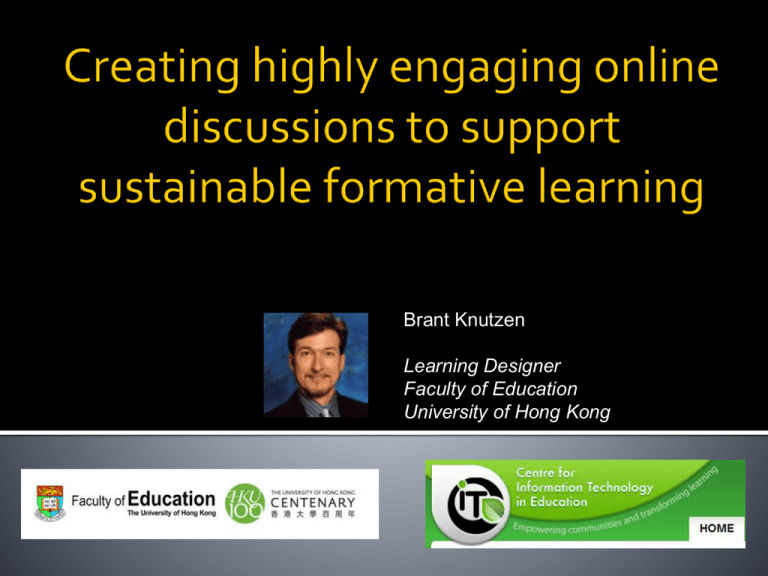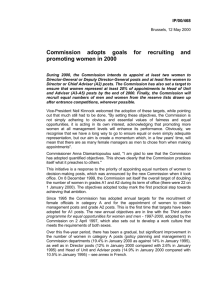The Participation Discussion Forum
advertisement

Brant Knutzen Learning Designer Faculty of Education University of Hong Kong Social Constructivism Transactivity Building engagement Assessment methods Participation rating Measuring engagement CMC : Computer-mediated Conferencing Synchronous : “chat”, or instant messaging Asynchronous : “discussion forum” Asynchronous Participants take turns posting Minutes, hours, or days apart More time to digest, research, compose response The effective construction of knowledge is a product of a functional collaborative group producing artifacts for public display and use Efficacy has been found to be linked to the process that learners utilize in working on the task together (Fischer et al 2002) Process: social negotiation of arguments and argument sequences (Leitão 2000; Voss & Dyke 2001) John Biggs captured the educational value of discussion when he stated: "Good dialogue elicits those activities that shape, elaborate, and deepen understanding“ (Biggs 1999 p. 5) Transactivity: the method by which students build on the contributions of their fellow learners (Berkowitz & Gibbs 1983) Transactive communication: Participants respond to and build on each other’s contributions Peer exchange of information and ideas Social negotiation of knowledge Each participant brings their own experiences to apply to a common educational goal A key theoretical construct for measuring collaboration How can we formulate the instructional design conditions which consistently result in more productive and transactive learning activities? How can we describe it in easily grasped ways? Quantitative Qualitative An online discussion is a great formative learning activity for building depth of student understanding, or supporting project work Highest potential for social construction of knowledge and transactive collaboration Unfortunately, this activity is also the most likely to FAIL! Why? Case study of one course (Knutzen, 2007) ▪ ▪ ▪ ▪ International school in Hong Kong – secondary level 1-to-1 laptop blended learning environment Introduction to Psychology course Sample size = 24 Investigation of instructional design conditions to achieve a highly productive online discussion At start of study, average student production in optional online discussions = 1 post Four conditions to achieve productive online discussions: 1. Teacher facilitated social formation of small groups 2. Class time to initiate oral and online discussion interaction 3. Setting open-ended, challenging topic questions that encourage discussion and debate 4. Assessment system that reinforces production and peer interaction At end of study, average student production: over 10 posts per discussion! Over the past six years: Extensive use of the online discussion design Full-time instruction of secondary students ▪ 1-to-1 laptop environment ▪ IT classes ▪ Psychology Implemented at University of Hong Kong: 2009 ▪ MSc IT in Education course on eLearning Implemented in 12 courses at Lingnan Univ : 2010 ▪ Business, History, Social Studies, Philosophy, English Design continues to result in good production One to three questions around one topic or area of content / concepts Advantage of multiple questions: Instructor can design a “gradient” of difficulty which can elicit a range of student answers ▪ From basic knowledge -> higher-order thinking skills (HOTS) ▪ Use a taxonomy of active verbs to specify the levels of understanding expected in answers (Blooms Revised, SOLO) ▪ Examples: Multi-structural (list, describe, classify) Relational (compare/contrast, explain, analyze, relate) Extended Abstract (hypothesize, generate, reflect) Objective of multiple questions: Make discussion accessible to all students Challenge the advanced students Other topic question gradients found to be useful: Concrete facts -> abstract concepts Textbook context -> personal context (unique answers!) Example of a Topic Question gradient: Can you demonstrate what you have learned in your study of the Porter management models? 1. 2. 3. Can you list and describe the Porter models? (Basic understanding ) . How can you compare Porter's models? (Relational understanding) Can you relate these models to each other in several ways, or on several dimensions? . Based on these models, can you create your own model? What factors do you theorize are important, and why? (Extended abstract understanding) Traditional – teacher-assessed subjective marking Review contributions by each student Award mark based on: ▪ Participation – any contribution to discussion ▪ Interaction - responding and seeking feedback ▪ Transaction – sharing / exchanging useful information and resources ▪ Transformation – perspective change due to interaction with others Best method for summative assessment Should a discussion be a summative activity? Criteria examples: ▪ Locate, organize, analyze, evaluate, synthesize, and ethically use information from a variety of sources and media ▪ Interact, collaborate, and publish with peers, experts, or others employing a variety of digital environments and media ▪ Develop cultural understanding and global awareness by engaging with learners of other cultures ▪ Contribute to project teams to produce original works or solve problems Source: ISTE NETS for Students A highly productive discussion can easily produce over 200 posts a week! A teacher can become a victim of their own success How much time can they devote to quantitative marking? How much time remains for qualitative feedback? Desired graduate attributes: Critical thinking skills Excellent cooperative skills ▪ Integrity ▪ Personal responsibility Subjective peer-assessment can directly address the development of these attributes Requires student training Requires review and evaluation by teacher Possible problems: Revenge grading : 報復 ▪ “you gave me a low grade, I will give you a low grade” Back-scratching : 賄賂 ▪ “If you give me a high grade, I will give you a high grade “ Teacher evaluation of forums: time intensive Peer evaluation of forums: requires monitoring Subjective evaluation of formative work tends to distort student learning Optional forums do not get sufficient participation to create viable discussions My solution: automate the rating based on participation No subjective judgment, just rating using a systematic method: Moodle can automatically average these grades! Moodle averages the ratings Grades produced by participation: ▪ ▪ ▪ ▪ ▪ ▪ ▪ ▪ One post = 6 -> DTwo posts = 8 -> BThree posts = 8.6 -> B Four posts = 9 -> AFive posts = 9.2 -> ASix posts = 9.33 -> A Seven posts = 9.42 -> A Eight posts = 9.5 etc More Q&A participation = higher grade Number of posts -> Forum Grade 10 9 F o r u m 8 7 6 5 G r a d e 4 3 2 1 0 0 1 2 3 4 5 6 7 8 9 10 11 12 13 Number of discussion posts 14 15 16 17 18 19 20 21 This assessment method for assessing a forum creates a foundation of participation: on average over 90% of students will engage As always, the teacher’s role is to create the educational value of the activity: Set up challenging topic questions to guide exploration Maintain a “visible presence” in the forum activity Successfully moderate the discussion Salmon’s 5-stage model of eModeration Teacher guides students up the levels toward knowledge development Source: http://www.atimod.com/e-moderating/5stage.shtml The Moodle LMS handles the awarding of quantitative marks for participation Teacher can focus on quality: Monitor progress Guide the discussion Challenge students Time for thoughtful qualitative feedback ▪ Minimum: 30 mins to 1 hour each week per discussion Motivation on three levels: 1. Constructive alignment between formative discussions and summative final assignments Examples: ▪ Reflective posts build towards a Learning Portfolio blog ▪ Group collaboration on final project development 2. Social Constructivism: a sense of social obligation to support the group 3. Quantified Participation: each contribution is counted as participation towards a forum grade Automates the awarding of participation points Reduces technical requirements (modifying roles) No need to train the students No need to monitor rating accuracy No need to motivate student ratings of posts Finished development and testing in Dec 2011 Currently in trials at HKU Planned release as open-source project soon Quantitative: ▪ ▪ ▪ ▪ Production = Total number of discussion posts / n Interactivity = Total number of feedback posts / n Group Activity = Total number of discussion posts / # topics Transactivity = Production × Interactivity Qualitative: a new type of graphical representation – the “Participation Map” Developed at Lingnan University in 2011 Continued development as open source project New Moodle plug-in automates the production of the map of discussion activity: Quantitative statistics Qualitative graphic display: a “data portrait” Useful for displaying discussion activity Feedback to students in the class (who is working?) Feedback to teacher (what approach is working?) Anonymous mode for reporting research results Time scale from Day 1 to Day 14 Overall discussion statistics Red line shows rating cutoff Students can interact in multiple groups Group comparison stats Student profile pictures Quantitative ratings of overall discussion After install on Moodle server, this plugin is only available to those with Teacher roles New option on Course Administration block Select the forum, and then plot type: Normal plot for feedback to teacher and students Anonymous for reporting results outside Currently setting up a website to make these open source projects available to the Moodle educational community: Brant.Knutzen.se Goal is to release both as free open source plugins for Moodle 2 by Sep 2012 Q & A ?? My email is brantknutzen@gmail.com




